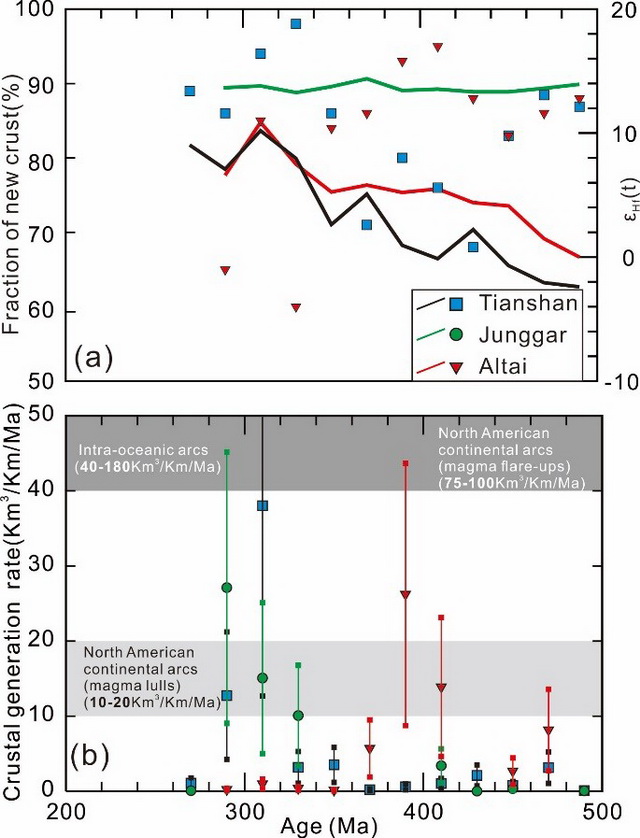Accretionary orogens are major sites of generation of continental crust but the spatial and temporal distribution of crust generation within individual orogens remains poorly constrained. The Central Asian Orogenic Belt (CAOB) extends from the Urals in the west, to the Okhotsk Sea along the eastern Russian coast, and it represents a major pulse of Phanerozoic continental growth (Sengör et al., 1993; Jahn, 2004; Kröner et al., 2007; Wilhem et al., 2012).
To better understand the crust generation rates and the tectonic activity to crust production of the CAOB, Dr. TANG Gongjian and his co-operators present for the first time a synthesis of whole rock Nd and zircon Hf isotope data of Paleozoic (~550-270 Ma) magmatic rocks from North Xinjiang, the southwestern part of the Central Asian Orogenic Belt (CAOB).
The results show that Paleozoic (~540–270 Ma) granitic rocks from the Alati, Junggar and Chinese Tianshan segments of the Central Asian Orogenic Belt (CAOB) have markedly bimodal age frequency distributions with peaks of ages at ~400 Ma and 280 Ma for the Altai segment, and ~430 Ma and 300 Ma for the Junggar and Chinese Tianshan segments (Figure 1). Most of the magma was generated in short time intervals (~20 – 40 Ma), and variations in magma volumes and in Nd–Hf isotope ratios are taken to reflect variable rates of new crust generation within a long-lived convergent plate setting. The Junggar segment is characterised by high and uniform Nd–Hf isotope ratios (εNd(t) = +5 – +8; zircon εHf(t) = +10 – +16) and it appears to have formed in an intra–oceanic arc system. In the Altai and Chinese Tianshan segments, the Nd–Hf isotope ratios (εNd(t) = -7 – +8; zircon εHf(t) = -16 – +16) are lower, although they increase with decreasing age of the rock units.
Our results suggest that: Within the long-lived convergent margin setting (over ~200 Ma), higher volumes of magma, and greater contributions of juvenile material, were typically emplaced over short time intervals of ~20 - 40 Ma. These intervals were associated with higher Nb/La ratios, coupled with lower La/Yb ratios, in both the mafic and granitic rocks, and these episodes of increased magmatism from intraplate-like sources are therefore thought to have been in response to lithospheric extension. The trace element and Nd-Hf isotope data, in combination with estimates of granitic magma volumes, highlight that crust generation rates are strongly non-uniform within long-lived accretionary orogens. The estimated crust generation rates range from ~0.1 to ~40 km3/km/Ma for the Paleozoic record of the CAOB, and only comparatively short (20 - 40 Ma) periods of elevated magmatic activity had rates similar to those for modern intra-oceanic and continental arcs (Figure 2).
http://www.sciencedirect.com/science/article/pii/S0012821X17300900

Figure 1. Histogram of zircon U–Pb ages for granitic rocks of the Altai, Junggar and Chinese Tianshan segments. The outcrop areas of the granitic rocks are compared for every 20 Ma time intervals. Grey and brown bars represent age peak and period of high rate magmatism. (Image by TANG Gongjian)

Figure 2. (a) Juvenile input for Chinese Tianshan and Altai segments calculated from the zircon Hf isotope data, compared with the average εHf(t)values for granitic rocks shown by broken lines; (b) Estimated rates of crust generation (km3/km/Ma) through time for the Chinese Tianshan, Junggar and Altai segments, adopting an average granite crustal thickness of 15 ±10km(error bars). (Image by TANG Gongjian)
Contact:
TANG Gongjian
Guangzhou Institute of Geochemistry, Chinese Academy of Sciences
Guangzhou, Guangdong 510640, China
E-mail address: tanggj@gig.ac.cn